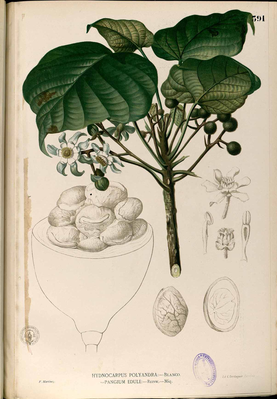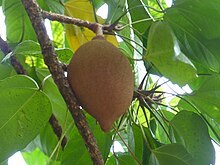Pangium edule
| Pangium edule | ||||||||||||
|---|---|---|---|---|---|---|---|---|---|---|---|---|

Pangium edule |
||||||||||||
| Systematics | ||||||||||||
|
||||||||||||
| Scientific name of the genus | ||||||||||||
| Pangium | ||||||||||||
| Reinw. | ||||||||||||
| Scientific name of the species | ||||||||||||
| Pangium edule | ||||||||||||
| Reinw. |
Pangium edule is the only species of the monotypic plant genus Pangium in the family of the Achariaceae . German-language common names are also Pangibaum or Kepayangbaum . All parts of the plant are poisonous. The epithet edule is Latin, means edible and refers to the seed . The seeds are onlyvaluedas a spice in Indonesian and Malay cuisineafter they have been pretreated as Keluak or Kepayang .
description
Vegetative characteristics
Pangium edule grows as an evergreen tree with a dense crown and reaches heights of up to 25–40 meters or more. The trunk diameter can reach 1 meter or more. On the upright trunk there are sometimes buttress roots that are several meters high . The bark is relatively smooth and gray-brownish. The tree does not begin to bear fruit until the age of 15 and it can get very old.
The leaves of young specimens are much larger than those of older trees. The alternate, spirally arranged, large and bare leaves are divided into a petiole and a leaf blade. The long petioles are 20–50 cm long. The simple, entire leaf blades are ovoid to heart-shaped and pointed, pointed or pointed at a length of about 15-40 centimeters, on older specimens they are sometimes more or less three or more lobed. The leaf nerve is palmate . Stipules are missing.
Generative characteristics
Pangium edule is mostly dioecious, separate sexes ( dioecious ), so the female and male flowers are on different specimens. However, hermaphroditic flowers can occur. The often pendulous flowers are on long stems. The female, axillary flowers usually appear singly and the male in few-flowered, long-stalked and racemose - panicle inflorescences .
The mostly unisexual, relatively large, about four to six-fold, slightly fragrant flowers have a double flower envelope . The calyx of the conical bud divides into irregular, two to four, smaller and green calyx lobes. The four to eight, tiled, laid back and fleshy, ovoid to elongated petals are greenish in color. Each petal has a larger, orange-brownish, initially fleshy, finely-pointed to slightly fringed and rounded scale ( secondary crown ) inside at its base . The male flowers contain about 20-25 free, short stamens with thick, white and fleshy stamens with white-reddish, mobile anthers. The female flowers have a few to many, small and awl staminodes. The uni-, large and cylindrical ovary is upper constant sedentary, disc-shaped scar .
The large, egg to pear-shaped, brownish fruit ( berry ) hangs individually on the branches like an ostrich egg, it is about 20-30 cm long and weighs up to 2.5 kg or more. The thick-skinned, multi-seeded and non-opening, rough, bare fruit is patterned and warty-dotted and contains about 15-30 large, chestnut-like, lumpy seeds that are irregularly shaped and layered. The fruit that is initially leathery and then soft when ripe is reminiscent of the Brazil nut fruit , which belongs to the potted fruit tree family. The large, nutty and thick-shelled, quite hard, more or less flattened, round to egg-shaped or angular seed (3 to 6 cm × 2 cm × 4 cm) weighs between 15 and 25 g with a soft, white taste of almonds or hazelnuts Core. The kernel is not eaten fresh as it is otherwise poisonous. The seeds are encased by a white-yellowish, oily-fleshy and edible aril , or a sarcotesta , which then dries up and falls off, adhering, underneath there is a first blackish and then grayish to later brownish, leathery-woody and veiny Shell (sclerotesta). Beneath it sits, relatively loosely, the inner core with a dark brown to blackish, thin and hard shell (endotesta). The seeds with an elongated and lipped hilum are good buoyant.
Systematics
The generic name Pangium comes from the Vorlinnaean period and was coined by Georg Eberhard Rumpf . The German-Dutch naturalist lived on Ambon for 45 years . He named other names such as: Pangi, Capaya, Copaya and took over the native names of the prepared seeds as Caluac and Colowac (Indonesian: Keluak or Kluwak).
The accepted name Pangium edule goes back to Caspar Georg Carl Reinwardt . The specific epithet in Latin edulis suggests edible parts of plants. The kernel can only be used in the kitchen as "Keluak" after the seed has been pretreated.
Pangium edule is the type species of the genus Pangium and probably its only species. The species Pangium ceramense Teijsm were also included in the genus Pangium . & Binn. ex Slooten , Pangium naumannii Warb. and Pangium rumphii Voigt , but most of them take them as synonyms. Synonyms for Pangium edule Reinw. are: Hydnocarpus edulis (Reinw.) Peterm. , Hydnocarpus polyandra Blanco .
The pangium belongs with about ten other genera to the tribe Pangieae within the family Achariaceae .
Occurrence and use
Pangium edule is widespread in Southeast Asia as far as Papua New Guinea and thrives in the wetlands of the mangrove forests . Pangium edule is rarely cultivated. The seeds for processing into Keluak mostly come from wild stocks.
The seed core is poisonous when raw, the concentration of hydrogen cyanide is quite high. After washing and boiling the seed several times and then burying the seed for a few days in soil or straw, the seed core is fermented and turns black to black-brown. These seeds of the pangi tree, known as "Keluak", can be safely used in the kitchen.
An oil can also be obtained from the seeds, but this must be heat-treated to neutralize the toxins. It used to be used in the kitchen for baking or as lamp oil. The sweet and aromatic fruit pulp of the ripe fruits can also be consumed.
Keluak is the main ingredient of Rawon (beef soup) in East Java, for the Peranakan (chicken dish) in Malaysia and Singapore and of Pamarassan (pork dish) for the Toraja in Sulawesi. The forest population used the tree bark and leaves as a pest control (insecticide) and for wound healing.
Although parts of the plant of the pangi tree are harmful to most animals such as chickens, cattle, and fish, falling fruits from this tree are consumed by Togian deer boars , Sulawesi giant squirrels, and Tonkean macaques .
There is an old tree in the Singapore Botanical Gardens , and a warning is issued here about the “Dangerous Keluak”.
The wood is hard but not very durable, it can be used for some applications.
Individual evidence
- ^ Juan V. Pancho, William Sm. Gruézo: Vascular flora of Mount Makiling and Vicinity (Luzon: Philippines). Part 2, edited by National Academy of Science and Technology (NAST) Philippines, 2006, ISBN 971-8538-78-X , download .
- ^ Georg Eberhard Rumpf: Herbarium Amboinense. De Pangi boom. Liber III, Cap. XIII, 1741.
- ^ Sylloge Plantarum Novarum. Nov. II, 1828, 12.
- ↑ Pangium The Plant List (2013) Version 1.1. Royal Botanic Gardens, Kew and Missouri Botanical Garden , accessed November 23, 2017
- ↑ Mark W. Chase, Sue Zmarzty, M. Dolores Lledó, Kenneth J. Wurdack, Susan M.Swensen, Michael F. Fay: When in Doubt, Put It in Flacourtiaceae: A Molecular Phylogenetic Analysis Based on Plastid rbcL DNA Sequences. In: Kew Bulletin. Volume 57, Issue 1, 2002, pp. 141-181.
- ↑ Data sheet at Gernot Katzer's Spice Pages .
- ^ Georg Eberhard Rumpf: Herbarium Amboinense. 1741, p. 183.
- ^ National Parks Board - Singapore .
Web links
- Pangium edule at Useful Tropical Plants.
- Pangium in phytoimages.

